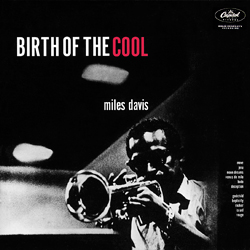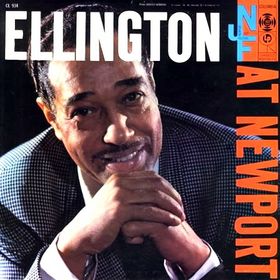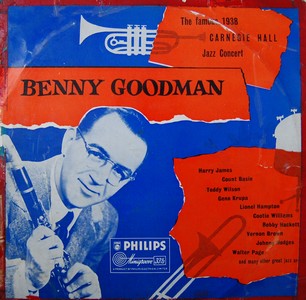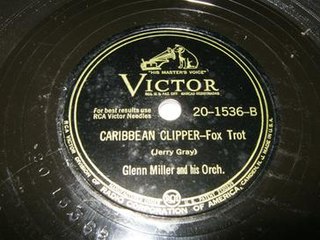McKinney's Cotton Pickers were an American jazz band, founded in Detroit, Michigan, United States in 1926, and led by William McKinney, who expanded his Synco Septet to ten players. Cuba Austin took over for McKinney on drums, with the latter becoming the band's manager. Between 1927 and 1931, they were one of the most popular African American bands. Many of their records for Victor were bestsellers.
Crescent Records was an American independent record label that produced jazz recordings from 1944 to 1946. It was founded by Nesuhi Ertegun to record a band that was assembled to perform on CBS Radio's 1944 variety series The Orson Welles Almanac. Only one group, Kid Ory's Creole Jazz Band, was released on the Crescent label, which was distributed by Hollywood's Jazz Man Record Shop. Although only eight discs were released, Crescent Records was involved in the international revival of traditional jazz in the 1940s.

Miles Ahead is an album by Miles Davis that was released in October 1957 by Columbia Records. It was Davis' first collaboration with arranger Gil Evans following the Birth of the Cool sessions. Along with their subsequent collaborations Porgy and Bess (1959) and Sketches of Spain (1960), Miles Ahead is one of the most famous recordings of Third Stream, a fusion of jazz, European classical, and world musics. Davis played flugelhorn throughout.

The Mills Blue Rhythm Band was an American big band active during the 1930s.

"Mood Indigo" is a jazz song with music by Duke Ellington and Barney Bigard and lyrics by Irving Mills.

Birth of the Cool is a compilation album by American jazz musician Miles Davis, released in February or March 1957 on Capitol Records. It compiles eleven tracks recorded by Davis's nonet for the label over the course of three sessions during 1949 and 1950.

Swing and Dance with Frank Sinatra is the sixth studio album by Frank Sinatra. The tracks were arranged and conducted by George Siravo and his orchestra. Original Columbia 10-inch 33 1/3-rpm LP and 78-rpm album set released October 16, 1950; the 7-inch 45-rpm EP and EP box sets were released in October 1952.

George Edward Bruns was an American composer of music for film and television. His accolades include four Academy Award nominations, and three Grammy Award nominations. He is mainly known for his compositions for numerous Disney films spanning from the 1950s until the 1970s, among them Sleeping Beauty (1959), One Hundred and One Dalmatians, The Absent-Minded Professor, The Sword in the Stone (1963), The Jungle Book (1967), The Love Bug (1968), The Aristocats (1970), and Robin Hood (1973).

Ellington at Newport is a 1956 live jazz album by Duke Ellington and his band of their 1956 concert at the Newport Jazz Festival, a concert which revitalized Ellington's flagging career. Jazz promoter George Wein describes the 1956 concert as "the greatest performance of [Ellington's] career... It stood for everything that jazz had been and could be." It is included in the book 1001 Albums You Must Hear Before You Die, which ranks it "one of the most famous... in jazz history". Jazz journalist Scott Yanow wrote that Ellington's performance at the 1956 Newport Jazz Festival caused a sensation that fueled the rest of his career.The original release was partly recreated in the studio after the Ellington Orchestra's festival appearance.

Kenneth Colyer was an English jazz trumpeter and cornetist, devoted to New Orleans jazz. His band was also known for skiffle interludes.

The Famous 1938 Carnegie Hall Jazz Concert by Benny Goodman, Columbia Records catalogue item SL-160, is a two-disc LP of swing and jazz music recorded at Carnegie Hall in New York City on January 16, 1938. First issued in 1950, the landmark recording captured the premiere performance given by a big band in the famed concert venue. The event has been described as "the single most important jazz or popular music concert in history: jazz's 'coming out' party to the world of 'respectable' music." Both critical and public reception of the performances was outstanding.
Chris Tyle is dixieland jazz musician who performs on cornet, trumpet, clarinet and drums.

Louis Armstrong Plays W. C. Handy is a 1954 studio release by Louis Armstrong and His All Stars, described by Allmusic as "Louis Armstrong's finest record of the 1950s" and "essential music for all serious jazz collections". Columbia CD released the album on CD in 1986 in a much altered form, with alternative versions in place of many of the original songs, but restored the original with its 1997 re-issue, which also included additional tracks: a brief interview by the producer, George Avakian, with W. C. Handy; a joke told by Louis Armstrong; and several rehearsal versions of the songs.

Donald Douglas Lamond Jr. was an American jazz drummer.
Ernie Carson was an American Dixieland jazz revival cornetist, pianist, and singer. He was born in Portland, Oregon.

Johnny Mathis is the first studio album by vocalist Johnny Mathis that was released by Columbia Records in 1956. The subtitle A New Sound in Popular Song can be found on the back cover but not on the front of the album or the disc label; in fact, this Mathis LP has been referred to as "the jazz album".

City of Glass, an album originally issued as a 10" LP by Stan Kenton, consists entirely of the music of Bob Graettinger. The original album has been reconstituted in different LP re-issues, and the entire set of Kenton/Graettinger Capitol Records sessions is on the digital CD City of Glass.

"Caribbean Clipper" is a big band and jump song recorded by Glenn Miller and his Orchestra in 1942. The song was composed by Jerry Gray with lyrics by Sammy Gallop. The song was part of a number of songs—including "Sun Valley Jump", "Here We Go Again", "The Spirit Is Willing", "The Man in the Moon" and "A String of Pearls"—written by Gray, a member of the Glenn Miller Orchestra as an arranger, specially for Glenn Miller, who recorded it in 1943. The song was registered with the United States Copyright Office on October 23, 1942, by the Mutual Music Society.
The Glenn Miller Orchestra is a band formed after the loss of Glenn Miller, named in memory of him and the original Glenn Miller Orchestra.














